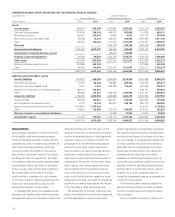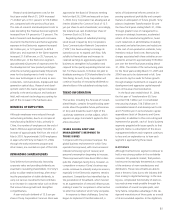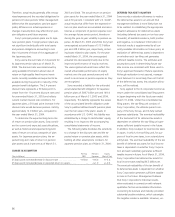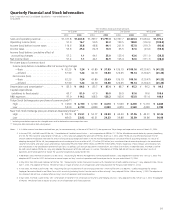Sony 2004 Annual Report Download - page 84
Download and view the complete annual report
Please find page 84 of the 2004 Sony annual report below. You can navigate through the pages in the report by either clicking on the pages listed below, or by using the keyword search tool below to find specific information within the annual report.82
however, complicated functionality has become
concentrated on semiconductors and other key
digital devices. Since these semiconductors and
key devices are able to be mass produced, they
have become readily available to new market
entrants, and the functionality that once com-
manded a high premium has become more
affordable. This has led to intense price erosion
in the end-user consumer AV products market.
To respond to these challenges, Sony is striving
to keep pace with price erosion by reducing its
manufacturing and other costs. It is seeking
to maintain the premium pricing it enjoys on
many of its end-user products by adding
functionality to those products and developing
new applications and ways of use that are
then communicated to the consumer. And it
is taking steps to increase its competitive
edge by developing high value-added semi-
conductors and other digital key devices in-
house. By increasing the ratio of key devices
produced in-house, Sony aims to capture the
value that has become increasingly concen-
trated in those devices.
In the area of semiconductors, Sony in-
vested 69 billion yen in the fiscal year ended
March 31, 2004 and plans to invest 120 billion
yen in the fiscal year ending March 31, 2005
on semiconductor fabrication equipment built
at the 65 nanometer level of process technol-
ogy. These chips will be some of the most
highly advanced on the market, and will in-
clude the new microprocessor for the broad-
band era, code-named Cell, as well as other
system large scale integration (“LSI”) for use in
the next generation computer entertainment
system and a variety of future consumer elec-
tronics products. Sony began developing Cell
together with IBM Corporation and Toshiba
Corporation in the spring of 2001. To ensure
efficient use of all the semiconductor produc-
tion facilities in the Sony Group, Sony is also
planning to consolidate the semiconductor
fabrication facilities of the Electronics and
Game segments into one organization on July
1, 2004.
In the area of other key devices, Sony is
currently investing in 7th generation amorphous
TFT LCD panel production equipment, reflect-
ing its belief that demand for LCD televisions
will continue to increase rapidly. Sony is invest-
ing one billion U.S. dollars in a joint venture it
has established with Samsung, named S-LCD
Corporation, and based in South Korea.
Samsung holds 50 percent plus one share of
the equity of the joint venture while Sony holds
50 percent minus one share of the equity of
the joint venture. The President and CEO
comes from Samsung while the CFO comes
from Sony. Investment in manufacturing
equipment will begin in the summer of 2004
while mass production of LCD panels is ex-
pected to begin in the second calendar quarter
of 2005. Expected production capacity is
60,000 sheets per month at the 7th generation
(1,870 mm x 2,200 mm) level of technology.
GAME
In the Game segment, PlayStation 2 has a high
share of the global game console market, and
the PlayStation 2 business, particularly the
PlayStation 2 software business, remains in its
harvest stage. However, production shipment
units of PlayStation 2 hardware are expected
to decrease in the fiscal year ending March 31,
2005. In order to ensure future growth in the
Game segment, Sony is investing, as described
above, in the research and development of
cutting-edge microprocessors and other LSIs
that will be used in the next generation com-
puter entertainment system. Furthermore,
Sony is working to develop a new market
through its planned introduction, in the fiscal
year ending March 31, 2005, of PlayStation
Portable (“PSP”), a new handheld game system
on which a variety of content can be enjoyed.
MUSIC
In the Music segment, album sales over the
past several years have decreased due to the
worldwide contraction of the global music
industry brought on by piracy and competition
from other entertainment sectors. Although
Sony experienced improvement in a number of
key retail markets during the fiscal year ended
March 31, 2004, it continued to record declin-
ing sales on a global basis. In an effort to
maintain profitability, Sony is continuing to
implement restructuring initiatives designed to
reduce fixed costs at a rate equal to or above
the rate of the decline in sales. Sony is also
working to combat digital piracy and generate
profits through digital distribution of content,
most notably through its launch of the Connect
music store, a digital downloading service.
Finally, in an effort to achieve significant
operational efficiencies, Sony is seeking to
merge its recorded music business with BMG.
In December 2003, Sony and Bertelsmann AG
announced that they had signed a binding
agreement to combine their recorded music
businesses in a joint venture. The newly
formed company, which will be known as
Sony BMG, will be 50 percent owned by each
parent company. The merger is subject to
regulatory approvals in the U.S. and the
European Union.
PICTURES
In the Pictures segment, Sony faces intense
competition, rising advertising and promotion
expenses and a growing trend toward digital
piracy. To meet these challenges, Sony is
working to distribute a diversified portfolio of
motion pictures and capitalize on the expand-
ing DVD home entertainment market, which is
becoming a more significant source of revenues
and profits. Additionally, to differentiate itself
in the marketplace and to proactively address
risks of digital piracy, Sony Pictures Digital is
developing broadband network strategies to
facilitate the integration between Sony’s hard-
ware and content products and create pro-
tected revenue-generating alternatives.
FINANCIAL SERVICES
In the Financial Services segment, the value of
assets accumulated by the businesses in the
segment has grown continuously over the past
several fiscal years, resulting in a large portion
of Sony’s total assets being accounted for by
the Financial Services segment. To strengthen
asset management and risk management in
parallel with this growing asset value, enhance
disclosure of business details, and offer cus-
tomers integrated financial services tailored to
their individual needs, Sony established Sony
Financial Holdings Inc. in April 2004. This com-
pany is comprised of Sony Life, Sony Assurance
and Sony Bank, and will serve to increase the
synergies between these businesses.
























